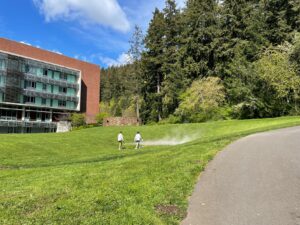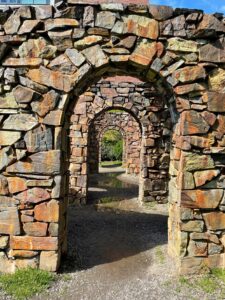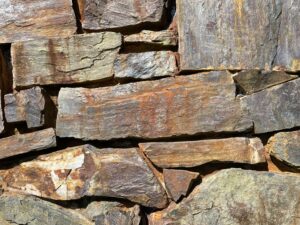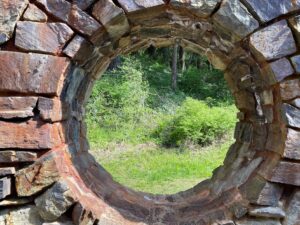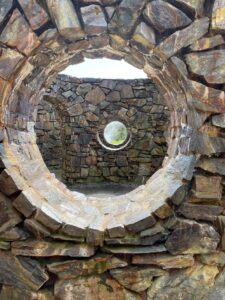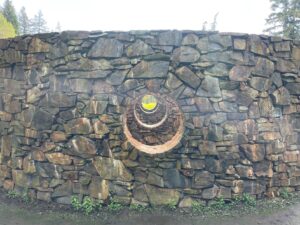

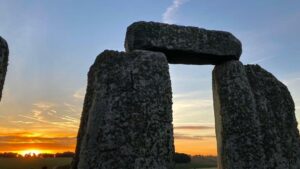
Right after we arrived in London, we went to the Stonehenge exhibition at the British Museum. I got free press passes for me, Henry and Henry’s sister, Imogen.
There were so many amazing aspects to this display that it is impossible to convey the depth and extent of the experience. Not to mention the complexity of the information provided.
Stonehenge was constructed at around the same time, 4,500 years ago, as the Sphinx and the Great Pyramid of Giza in Egypt.
The exhibition spanned the
Mesolithic (c. 12,000–6,000 years ago),
the Neolithic (c. 6,000–4,500 years
ago) and
the Bronze Age (c. 4,500–2,800 years ago).
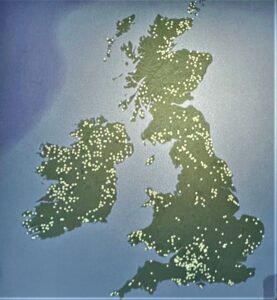
Here is the first image in the Stonehenge exhibition at the British Museum. I took a still from the video that shows how many Neolithic sites have been found in the United Kingdom. The exhibition also includes work from Europe. This photo shows most of the 1300 sites discovered in the UK, it does not include Brittainy. The first alignments with the solstice have been located as dating to 3700 BC
“Stonehenge’s significance changed enormously about 4,000 years ago, as it gradually became the central point around which hundreds of burial mounds were raised. Across Britain and Ireland during this period the importance of death and the role of grave goods in expressing ideas and identities reached its peak” cat p. 20)
The early societies were connected to nature, to the heavens and to one another.
There was an overall trajectory from peaceful, celestial worshipping communities, to, farmers, to guess what, social hierarchies based on wealth and then marking territory and warfare. the transition from stone to metal was a key moment for the change from communal society to individualism.
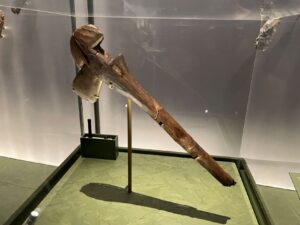
A polished axe made from porcellanite from County Antrim, Northern ireland, and deposited in a bog c. 3500–3000 BC Shulishader, isle of Lewis, Outer Hebrides, Scotland Porcellanite stone and rosaceous wood (hawthorn or apple),
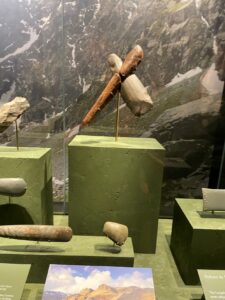
Beautiful display of stone axes.
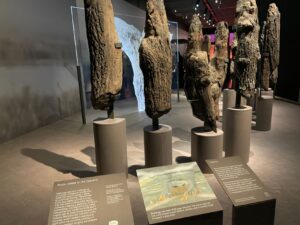
Seahenge wooden circle found in Norfolk created 2900BC
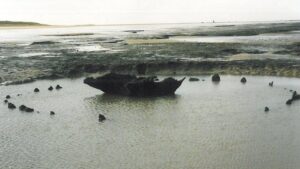
In situ Seahenge Norfolk 1998 copyright David Robertson
I realized as I was writing this that I visited a Neolithic burial site with my 87 year old mother in law in 1995 at Barclodiad y Gawres (Welsh for “The Giantess’s Apronful”) near Aberffraw in Anglesey
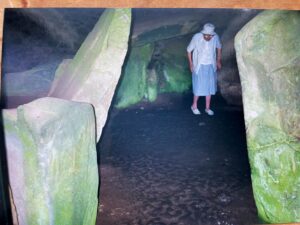
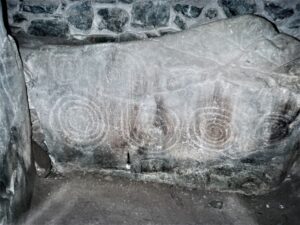
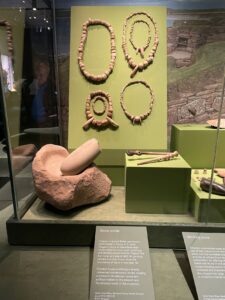
Necklaces ivory bone and tusk Finds from Skara Brae, c. 3100–2500 BC Skara Brae, mainland, orkney, Scotland
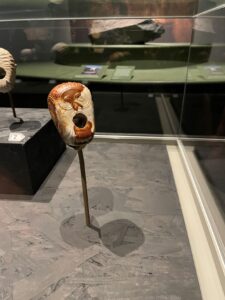
The Knowth decorated mace-head, Flint c. 3500–3000 BC Knowth, County Meath, Republic of Ireland
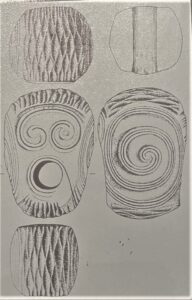
Elaborate relief incised into flint. These extraordinary objects were so beautifully displayed!
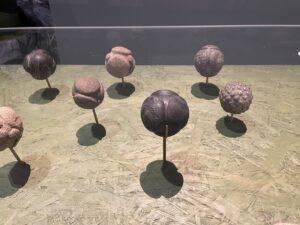
The Towie decorated and carved stone balls, c. 3000 BC Towie, Aberdeenshire, Scotland Stone, diam. 7.3 cm National Museums Scotland,
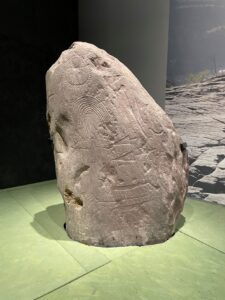
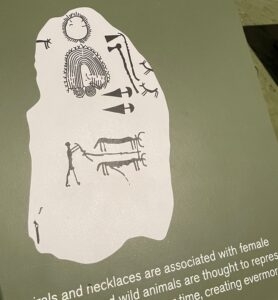
These incised stones were found in the open air, not in a burial.
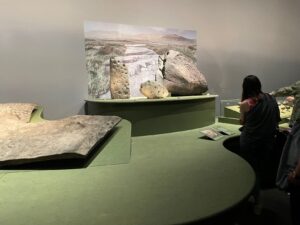
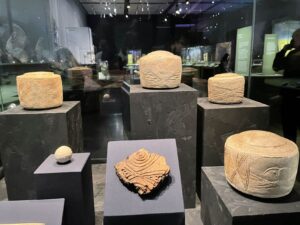
the Folkton ‘drums’ or cylinders, found with the burial of a child, c. 3000 BC Folkton, north Yorkshire, england Chalk, H. 11.9 cm, diam. 14.4 cm (largest piece), H. 8.3 cm, diam. 10 cm (smallest piece) British museum, 1893
Now we move on to the age of metal and gold, a significant change in the society. Status comes in!
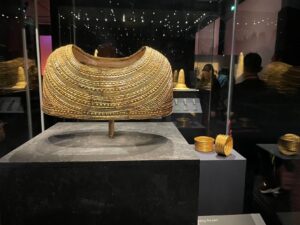
Lunula, 2400–2000 BC Blessington, County Wicklow, Republic of Ireland Gold, diam. 22.1 cm British Museum, WG.31 Donated by John Pierpont Morgan
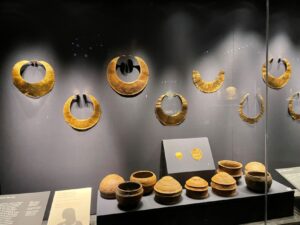
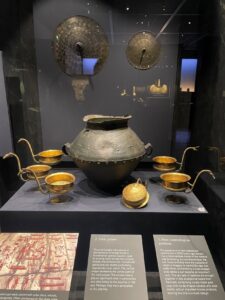
The Mariesminde hoard, c. 1000–700 BC Mariesminde Mose, Funen Island, Denmark Bronze and gold, H. 20.5 cm, W. 14 cm (each cup), H. 35 cm, W. 42 cm (vessel) National Museum of Denmark,
Those conical bronze shapes on the wall were placed on women’s stomachs in Scandianavian graves. THey are covered with symbols of sirals and sun motifs symbolizing regeneration and rebirth. The connical shape represents the center point of the sun’s power.
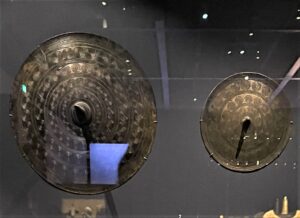
Here is the most exciting and beautiful piece in the exhibition!
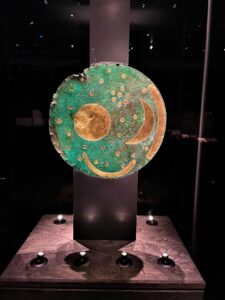
The nebra sky disc, buried c. 1600 BC nebra, saxony-Anhalt, Germany Gold and bronze, diam. 32 cm state offi ce for Heritage Management and Archaeology saxony-Anhalt, Halle, Hk
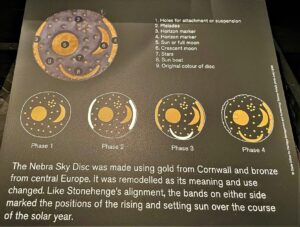
This sky disc was one of the most exciting pieces in the exhibition
It gives us the subtlety of the early understanding of constellations, and in its materials, speaks of the exchange of goods over long distances, It included bronze from Central Europe.
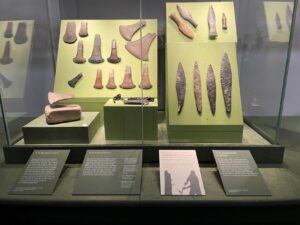
Axe heads 1700–1500 BC Arreton Down, Isle of Wight, England Bronze, L. 17.2 cm, W. 9.9 cm
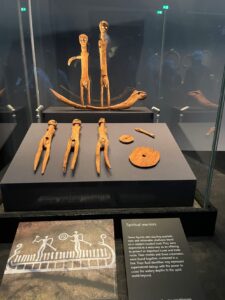
Spiritual Warriors on Serpent headed boat
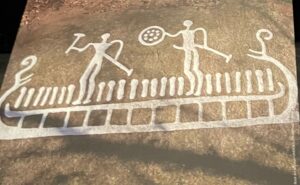
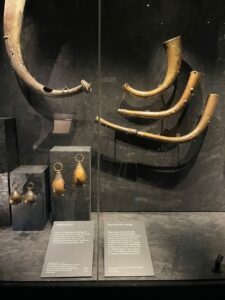
Horns and bells , bronze, Dowris hoard, 950–750 BC County Offaly, Republic of Ireland
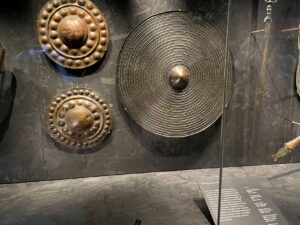
Shields, bronze, Isis River, oxfordshire, england diam. 34 cm British Museum, Rhyd-y-Gorse, Ceredigion, Wales, British Museum,
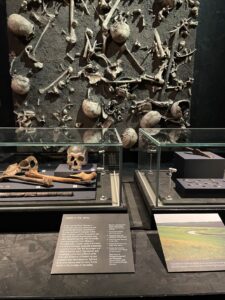
the grim conclusion of a battlefield
The British Museum did a stunning job of installing, sequencing, and explaining these sometimes esoteric objects. They carefully gave equal privilege to the humble works of ax heads and the gold necklaces. They also gave us a sense of what holds a society together ( a shared belief system) and what makes it fall apart, land cultivation, property, then competition, individualism, and finally warfare.
But there were also protests. Shockingly there is a plan to build a road under Stonehenge
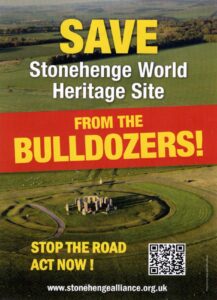
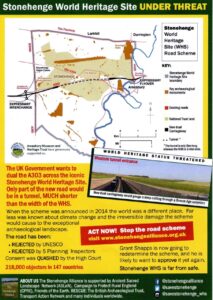
As well as BP sponsorship of the exhibition and the British Museum in general On the right it describes how BP while sponsoring this exhibition is simultaneously destroying indigenous Rock Art in Murujuga Western Australia 10 times older than Stonehenge
and much more: the issue of repatriation and the effects of the cllimate crisis on communities most affected by BP
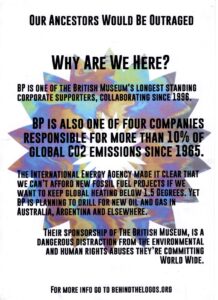
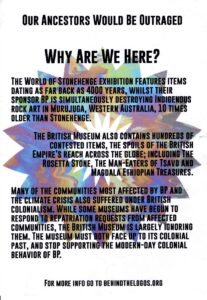

The image behind the text is a reworking of BPs sunny greenwashing logo which is why this group is called behindthelogos.org
Just in case that isn’t enough bad news about BP, I read today on the site “We Don’t Have Time” a post that said
“BP to ramp up oil output, inaugurate U.S. Gulf platform in 2022 BP (NYSE:BP) expects to double crude oil production from its Thunder Horse project in the U.S. Gulf of Mexico and launch its latest production platform by the end of this year”
The company expects to produce ~200K boe/day by year-end 2022 from the current 100K boe/day at Thunder Horse, according to Starlee Sykes, BP’s Senior VP for the Gulf of Mexico and Canada.
BP (BP) also is preparing to start its fifth operated platform this year – Argos – the centerpiece of its $9B Mad Dog 2 project in the Gulf, but Sykes declined to specify in which quarter production would start.
“More Gulf of Mexico oil and gas helps improve emissions globally,” Sykes said, according to Reuters.
Last September, BP (BP) announced the start-up of Thunder Horse South’s phase 2 expansion and said a total of eight wells would be drilled to increase oil and gas production to ~400K boe/day by the mid-2020s.”
**************************************************
As Neolithic Art is an area far outside my expertise, it was fortuitous that as soon as I got back to Seattle, I went to a symposium about Nancy Holt’s Rock Rings 1977-78 at Western Washington University.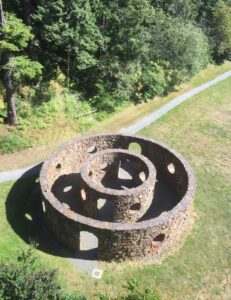 ,
,
which draw on her exploration of Neolithic sites that she visited with Smithson in 1969 as well as her interest in celestial constellations and stone construction. They were completed after her more famous Sun Tunnels, and only four years after Smithson’s death. They align with Polaris the North Star. Her Sun Tunnels, 1973-76, like Stonehenge, align with the Summer Solstice.
Rock Rings is constructed of Triassic era Schist.
